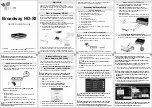
64
The PCBs
-
The radio consists of two PCBs, the RF (rear side) and control board (front side)..
-
On the RF Board, connect ANT1 to a signal generator or RF power meter.
-
On the RF Board, connect Power Supply to the battery terminal contacts.
-
Connect External Speaker Mic Plug (or Audio Test Jig) to J3.
3) TRANSMITTER CIRCUIT ADJUSTMENT
-
Crystal frequency
On receiving mode, check Crystal output is at 12.8MHz
-
Transmitter Frequency
Connect RF Power meter to ANT1, Activate PTT to transmit on 146.125MHz.
-
Transmitter Output Power
Activate PTT to transmit on 146.125MHz, Output power is adjustable by software
-
Transmitter Sub-Audible Tone Deviation
Set radio to transmit on M146.125Hz, with CTCSS code 01 (67Hz) and no audio modulation. It is adjustable by
software for 0.45KHz deviation.
-
Transmitter Deviation Limit
Set radio to transmit on 146.125MHz, with CTCSS code 01 (67Hz) and audio modulation. At the external
microphone input, inject 1KHz tone at –20dBm. It is adjustable by software for 2.3KHz deviation.
4) RECEIVER CIRCUIT ADJUSTMENT
-
FM Demodulator Adjustment
Set radio to receive on 146.125MHz, No CTCSS or DCS. Connect RF Signal Generator to ANT1, Set generator to
146.125MHz at –60dBm (50
Ω
) output with 1KHz tone modulation at 1.5KHz deviation.
-
Receiver Squelch Adjustment
After checking the receiver sensitivity, further lower the RF Signal Generator output to 8-10dB SINAD and observe
the squelch circuit operates. Adjust VR201 if necessary.


























